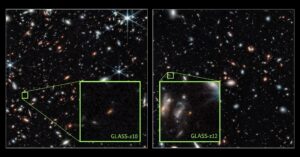Latest news from DAWN
Astronomers from the Cosmic Dawn Center have unveiled the nature of the densest region of galaxies seen with the James Webb Space telescope in the early Universe. They find it to be likely the progenitor of massive, Milky Way-like galaxy, seen at a time where it is still assembling from smaller galaxies.
Read MoreCongratulations to Bitten Gullberg who has just been awarded DKK 5.5 million by the Villum Foundation through their Young Investigator Programme, funding her project “Exploring the infLuence of the Local envIronment on the Production of Stars In Starbursts” (ELLIPSIS).
Read MoreCharlotte Mason has received the “Semper Ardens: Accelerate” grant from the Carlsberg Foundation of DKK 5,000,000. The grant will be used to investigate how, and when, the first stars in the Universe formed.
Read MoreAfter half a year of frequent new candidates for the most distant galaxy ever seen, astronomers have finally acquired the conclusive evidence: a spectrum, allowing the researchers to measure the exact wavelengths of the light emitted from the galaxies in the past, and hence to determine their distances unambiguously. Four galaxies have been confirmed, with the most distant one seen only 320 million years after the Big Bang.
Read MoreGamma-ray bursts are the most powerful explosions in the Universe, resulting from either collapsing stars or from the collision of two compact stellar remnants. But a recent discovery fits in neither, or both, of these categories, challenging our understanding of their source. Astronomers from the Niels Bohr Institute played an important role in the study that may lead us to revise our theories about these violent events.
Read MoreLess than a week after the James Webb Space Telescope was ready for science, the first reports of discoveries of galaxies at record distances and, consequently, at record-early times appeared in preprints. Even more remarkably, these galaxies seem to be so massive that they challenge our understanding of how structure forms in the Universe. Now the two first of these reports have undergone the mandatory peer-review and have been accepted for publication in the scientific journal The Astrophysical Journal Letters, substantiating the robustness of the result. However, astronomers are still waiting for the conclusive evidence — spectroscopy.
Read MoreCongratulations to Shouwen Jin, who for the second year in a row is among the most cited Chinese astronomers, earning him the prize from IOP Publishing.
Read MoreCongrats to Darach Watson and his collaborators with their successful ERC Research Synergy Grant! Their project HEAVYMETAL will provide a better understanding of the marvelous phenomenon “kilonovae” and their formation of the heavy elements in the Universe.
Read MoreWhile developing and testing astronomical software on existing data, a master student in astronomy fortuitously discovered a group of galaxies in the very early Universe. In addition to demonstrating the potential of the software, the finding provides insight into the assembly of massive structures, as well as how some galaxies cease to form stars.
Read MoreUsing the Very Large Telescope and the radio telescope ALMA in Chile, a team of astronomers including researchers from the Niels Bohr Institute has discovered a swarm of galaxies orbiting the surroundings of a hyper-luminous and vigorously star-forming galaxy in the early Universe. The observation provides important clues to how exceptionally bright galaxies grow, and to how they evolve into energetic quasars, beaming light across most of the observable Universe.
Read More










